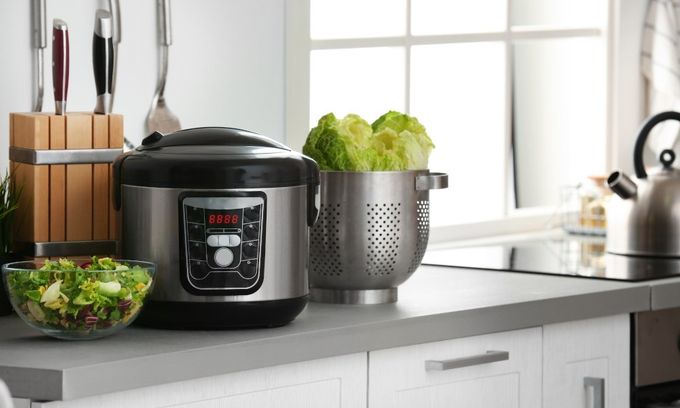In 1937 Japanese Imperial Army ordered device rapid preparation large amounts of rice for mobile car kitchens. Successfully developed device became the prototype of the modern rice cooker. It had a wooden box with two electrodes for heating water. But the first commercially successful model appeared on the market only in December 1956. It was developed by Japanese Toshiba Corporation and contained two working chambers placed one in the other. The outer circuit was intended for hot water, and the internal – for rice. Thermostat became its key feature, providing automatic shutdown after the end of the cooking cycle.
Today, this device still remains one of the most popular. Of course, modern models use a large number of innovative technologies that together with technical valumes of model affect the price and choice of the optimal rice cooker. But the design has remained very simple and has not changed much in recent decades.
Main function
The timer, thermostat and standard cooking programs.
These functions provide an automation of cooking process. Therefore, all modern models support programs for cooking porridge, stewing, baking and steaming.
Calibration.
Measuring cup, measuring spoon and dimensional lines on the wall of bowl greatly simplify dosage of ingredients according to the cooking recipe.
Non-stick coating.
The coating prevents food sticking to bowl walls and eliminates the need of periodic mixing during cooking. Some modern models use ceramic bowl.
Steaming.
A special basket provides steaming mode.
The thermos function.
This function provides maintaining the set temperature of finished dishes. The temperature range equals usually up to 65 degrees during 24 hours. This function uses data of a special sensor that controls the temperature of the finished dishes.
Visual control.
The transparent lid from fire resistant glass provides visual control of cooking process.
Steam discharge.
Models with the function of a pressure cooker provide smooth steam pressure decrease. Pressure gradually reduces after completion of the cooking program. This function increases operation safety and uses a steam valve.
Warming up.
The function periodically warms the finished dish to the preset temperature. In fact, it duplicates the thermos function.
Porridge.
This program provides cooking the Asian rice.
Uniform heating.
Tripartite placement of heaters on the bottom and in the walls or innovation system of induction heating provide a high degree of heating uniformity.
Pressure cooker.
Function provides accelerated cooking by high pressure.
Consistency.
This function is used for adjustment of the porridge consistency that varies from soft rice (as a filling for pies or pancakes) until crumbly rice for pilaf or salads.
Innovation functions
Function of fuzzy logic.
The function automatically adjusts temperature and cooking time for optimization of cooking process. This option is implemented in expensive models of the upper price segment.
Great Thermal Dancing Boil function (steaming at a temperature of 200 degrees).
Function provides cooking rice on special technology using intensive convection. Technology increases the volume of cooked rice on 10% and amino acid content on 17%. Rice additionally acquires a slightly sweet taste and characteristic flavor.
Diamond non-stick coating.
This technology is a 6 -layer coating the bowl surface. The inner coating is applied with the help of diamond spraying. Outer covering uses gold.
This coating additionally provides ideal thermal characteristics for very high degree of heating uniformity.
Control via the smartphone.
Control via smartphone was first implemented in the Panasonic SR-SX2 IH Jar Rice Cooker IH Series models in 2012.
Function requires Android operating system and FeliCa application (contactless technology for IS – cards from SONY).
The video at the end perfectly demonstrates the multifunctional Wi-Fi IH Rice Cooker from Xiaomi.
Delayed start
Unfortunately, many models support this function only in the few programs. Some programs (for example, milk porridge or yogurt) are poorly suited for cooking with a delay due to turning sour of dairy products without refrigeration. This function is very convenient for baking bread or cooking porridge on the water.
Timing organization differs slightly in models of different companies. Maximum time in Cuckoo models reaches of 13 hours. But company recommends use maximum delay up to 7-8 hours due to risk of food spoilage without refrigeration, especially in hot weather.
Many models require setting the cooking end time. The user should set the exact time, for example, 8 o’clock in the morning. In this case, the device is automatically activated taking into account the cooking time. Accordingly, the cooking ends in 8 o’clock.
The minimum of timer setting varies in different modes. For example, the minimum in program for white rice (cooking under high pressure) is 41 minutes. The minimum for porridge program equals 19 minutes. MultiChef program supports this function from 1 minute and more.
Some models use another algorithm. User sets a cooking start time. Accordingly, it should take into account the cooking duration for providing the desired end time. The maximum start delay is usually 9 hours.
Panasonic models provide this function only for three programs (programs for cooking the buckwheat, rice and dairy porridge). The timer provides time selection in range from 1 to 13 hours in increments of 30 minutes. These models also require the installation of time cooking end.
